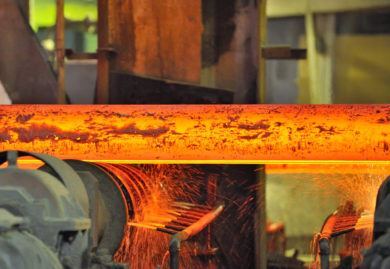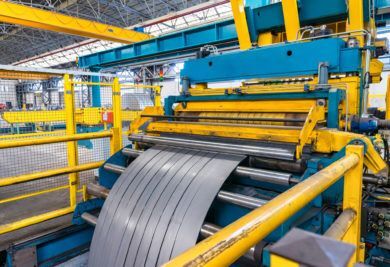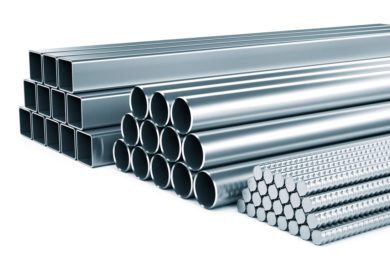Hot rolled and cold rolled steel processing has been the industry standard for decades. Each has advantages and disadvantages, giving each a special market position. Both are part of the rolled steel family.
What is Rolled Steel?
Rolling occurs to flatten a piece of steel to become thinner. The metal is passed through two rollers to be flattened. There are two types of rolling known as hot and cold rolled steel. The difference between these two types is the temperature of the metal when it is put through to be rolled.
Producing Steel
It is important to note that all steel is produced through a process using temperatures reaching 3,000° F to melt specific quantities of iron, manganese, nickel, chromium, molybdenum, boron, titanium, vanadium, tungsten, cobalt, niobium, and other minor elements into a molten solution that is cooled into steel slabs, bars, rods, blooms, or billets. In turn, those are shipped to customers for creating finished steel products. Many steel production plants use large-capacity conveyor equipment — such as the General Kinematics Furnace Charge Feeders, Dry/Wet Slag Cooling Conveyor, and Spira-Cool® Casting Cooling Spirals — to automate their production of raw products to the smelter.
Classifying Steel
Steel is rated according to its yield strength, for example, steel classified (by the American Society for Testing Materials) ASTM A36 steel has a minimum yield strength of 36,000 pounds per square inch (PSI). But it is possible to make steel with extremely strong yield strengths by adding different alloying elements, controlling the rate of cooling (tempering), and ‘working’ the steel in specific ways, such as cold rolling.
When steel is manipulated, two types of deformation can occur.
The first is elastic deformation; this is where the steel shape deforms because of the stress load imposed on the sample. When the load is reduced or removed, the steel returns to its original shape, like a spring. There is no permanent deformation.
Plastic deformation is where the steel deforms permanently because of an imposed load, and the resultant deformation is retained after the load is reduced or removed. A simple example would be the bending of a paper clip. It stays bent because you have exceeded the yield strength of the steel in the clip.
To shape the steel from a slab, rod, bloom, or billet, the rollers must apply more pressure than the yield strength of the steel. To achieve specific shapes, the steel is passed through various roller stations that manipulate the steel to conform to the shape of the roller one step at a time.
Heating the steel before the rolling process makes the steel more malleable and therefore easier to shape into more diverse shapes such as large I-beams used in construction or railroad tracks. However, while hot-rolled steel is cheaper to produce, there are several drawbacks to this process. One of the main drawbacks is the fact that the thickness and dimensions of the steel are not as accurate due to an unpredictable amount of shrinkage that takes place as the steel cools.
Cold Rolled Steel
From their names, one can guess the differences between the hot rolled and cold rolled processes. Both processes use rollers to apply pressure that manipulates the raw steel into desired shapes. Cold rolling manipulates the steel at room temperature whereas hot rolling involves reheating the steel to temperatures above 1,700° F.
The cold-rolled process creates a finished product that is more precise dimensionally and has sharper corners than a hot-rolled product. This is because, having already gone through the cooling process, it starts the rolling process closer to the finished dimension.
Another advantage of cold rolling is that it can increase the strength of steel, through what is called strain hardening, by up to 20 percent.
Identical steels classified (by the American Iron and Steel Institute) as AISI 1018 when hot rolled will have a tensile strength of 67,000 PSI and a yield strength of 45,000 PSI. However, when cold-rolled the tensile strength can increase to 85,000 PSI with a yield strength of 70,000 PSI.
However, the ductility of cold-rolled steel is decreased. Ductility is the extent to which a material can undergo plastic deformation, specifically, how far a material can be plastically deformed before fracture. A cold-worked material is, in effect, a normal (brittle) material that has already been extended through part of its allowed plastic deformation. If dislocation motion and plastic deformation have been hindered enough by dislocation accumulation and the stretching of electrical bonds of the atoms, the elastic deformation will have reached its limit, and fracture, the third mode of deformation, occurs.
Unfortunately, because of these properties, cold-rolled steel is limited to just a few shapes, such as round, square, flat, and variations of those types of shapes. Other shapes can be cold-rolled if the cross-section is uniform and the transverse dimension is small.
The cold-rolled method can produce a strong but thinner and more lightweight steel product with a smooth, shiny finish, but because of its decreased ductility, this processed steel is best suited for uses that don’t require flexing movements or stress. The ideal product uses include sheet metal used for metal furniture (e.g. desks, filing cabinets, tables, chairs), computer cabinets and hardware, home appliances and components, shelving, lighting fixtures, hinges, thin tubing, steel drums, metal containers, fan blades, frying pans, and a variety of construction-related products such as wall and ceiling mount kits.
Hot Rolled Steel
The hot-rolled steel, which has a grey scaly finish, is ideal for producing heavy-duty structural steel products that require a combination of strength and flexibility, such as construction beams that can absorb the swaying motion of bridges and buildings or steel tracks resilient to the impact of railroad cars. Other typical uses include truck frames, hopper cars, and railcar components, automotive clutch plates, wheels and wheel rims, thick pipes and tubes, agricultural equipment, strappings, metal buildings, guard rails for streets and highways.
Conclusion
Like other industries, steel manufacturing companies are on the verge of new ways to save energy during production and the development of lighter, stronger steel products.
If your manufacturing process is in need of an equipment upgrade, check out the complete line of products offered by General Kinematics or contact one of the company’s many worldwide offices.










